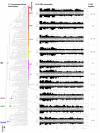IS4 family goes genomic
- PMID: 18215304
- PMCID: PMC2266710
- DOI: 10.1186/1471-2148-8-18
IS4 family goes genomic
Abstract
Background: Insertion sequences (ISs) are small, mobile DNA entities able to expand in prokaryotic genomes and trigger important rearrangements. To understand their role in evolution, accurate IS taxonomy is essential. The IS4 family is composed of approximately 70 elements and, like some other families, displays extremely elevated levels of internal divergence impeding its classification. The increasing availability of complete genome sequences provides a valuable source for the discovery of additional IS4 elements. In this study, this genomic database was used to update the structural and functional definition of the IS4 family.
Results: A total of 227 IS4-related sequences were collected among more than 500 sequenced bacterial and archaeal genomes, representing more than a three fold increase of the initial inventory. A clear division into seven coherent subgroups was discovered as well as three emerging families, which displayed distinct structural and functional properties. The IS4 family was sporadically present in 17 % of analyzed genomes, with most of them displaying single or a small number of IS4 elements. Significant expansions were detected only in some pathogens as well as among certain extremophiles, suggesting the probable involvement of some elements in bacterial and archaeal adaptation and/or evolution. Finally, it should be noted that some IS4 subgroups and two emerging families occurred preferentially in specific phyla or exclusively inside a specific genus.
Conclusion: The present taxonomic update of IS4 and emerging families will facilitate the classification of future elements as they arise from ongoing genome sequencing. Their narrow genomic impact and the existence of both IS-poor and IS-rich thriving prokaryotes suggested that these families, and probably ISs in general, are occasionally used as a tool for genome flexibility and evolution, rather than just representing self sustaining DNA entities.
Figures





Similar articles
-
Improving prokaryotic transposable elements identification using a combination of de novo and profile HMM methods.BMC Genomics. 2013 Oct 11;14:700. doi: 10.1186/1471-2164-14-700. BMC Genomics. 2013. PMID: 24118975 Free PMC article.
-
Causes of insertion sequences abundance in prokaryotic genomes.Mol Biol Evol. 2007 Apr;24(4):969-81. doi: 10.1093/molbev/msm014. Epub 2007 Jan 23. Mol Biol Evol. 2007. PMID: 17251179
-
Insertion sequence content reflects genome plasticity in strains of the root nodule actinobacterium Frankia.BMC Genomics. 2009 Oct 12;10:468. doi: 10.1186/1471-2164-10-468. BMC Genomics. 2009. PMID: 19821988 Free PMC article.
-
Insertion sequences in prokaryotic genomes.Curr Opin Microbiol. 2006 Oct;9(5):526-31. doi: 10.1016/j.mib.2006.08.005. Epub 2006 Aug 28. Curr Opin Microbiol. 2006. PMID: 16935554 Review.
-
Insertion sequence diversity in archaea.Microbiol Mol Biol Rev. 2007 Mar;71(1):121-57. doi: 10.1128/MMBR.00031-06. Microbiol Mol Biol Rev. 2007. PMID: 17347521 Free PMC article. Review.
Cited by
-
Phosphate coordination and movement of DNA in the Tn5 synaptic complex: role of the (R)YREK motif.Nucleic Acids Res. 2008 Oct;36(18):5855-62. doi: 10.1093/nar/gkn577. Epub 2008 Sep 12. Nucleic Acids Res. 2008. PMID: 18790806 Free PMC article.
-
Whole-genome sequencing analysis of two heat-evolved Escherichia coli strains.BMC Genomics. 2023 Mar 27;24(1):154. doi: 10.1186/s12864-023-09266-9. BMC Genomics. 2023. PMID: 36973666 Free PMC article.
-
New Wolbachia pipientis Genotype Increasing Heat Stress Resistance of Drosophila melanogaster Host Is Characterized by a Large Chromosomal Inversion.Int J Mol Sci. 2022 Dec 19;23(24):16212. doi: 10.3390/ijms232416212. Int J Mol Sci. 2022. PMID: 36555851 Free PMC article.
-
Comparative Genome Analysis of Two Streptococcus suis Serotype 8 Strains Identifies Two New Virulence-Associated Genes.Animals (Basel). 2024 Feb 8;14(4):572. doi: 10.3390/ani14040572. Animals (Basel). 2024. PMID: 38396540 Free PMC article.
-
Transposition of IS4 Family Insertion Sequences ISTeha3, ISTeha4, and ISTeha5 into the arc Operon Disrupts Arginine Deiminase System in Tetragenococcus halophilus.Appl Environ Microbiol. 2019 May 2;85(10):e00208-19. doi: 10.1128/AEM.00208-19. Print 2019 May 15. Appl Environ Microbiol. 2019. PMID: 30877114 Free PMC article.
References
-
- Chandler M, Mahillon J. In: Mobile DNA II. Craig NL, Craigie R, Gellert M and Lambowitz AM, editor. Washington, D.C., ASMPress; 2002. Insertion Sequences Revisited; pp. 305–366.
Publication types
MeSH terms
Substances
LinkOut - more resources
Full Text Sources
Other Literature Sources
Molecular Biology Databases

